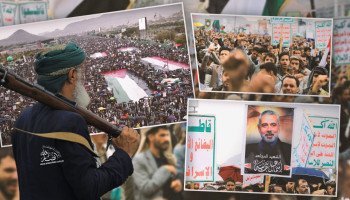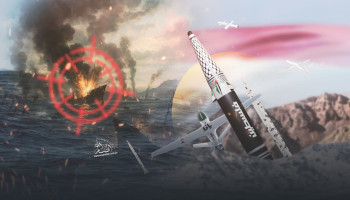Ansarollah Website Official Report
Published: Safar 11, 1447 AH
If the self-styled political and military leaders in the Zionist entity — along with their American counterparts — had paused for a moment to assess their futile war against the unarmed, besieged people in Gaza, they would have discovered many shocking truths. After 22 months of chaos, brutality, escalations, and the most savage methods of extermination, the situation remains unchanged: the enemy is still entangled in the same dilemma — a resistance that refuses to surrender.
The enemy has failed politically, failed militarily, and, more critically, has failed to maintain the illusion of power it had long tried to implant in global consciousness, particularly in the Arab and Islamic worlds. In its attempt to deter regimes and populations from even acknowledging the existence of an occupying power and an oppressed people subjected for decades to brutal practices by Israel and the United States, their crimes have instead been exposed to the world, opening more eyes than ever before.
The Failure of Assassination Policies
Amid mounting frustration as it bleeds resources and troops in a war of annihilation without achieving any strategic objective to bolster its regional influence, the enemy — during a recent "war council" meeting — concluded that assassinating resistance leaders was its only hope of destroying the resistance itself. While many viewed this approach as a reflection of strategic failure, Zionist leaders believed it was the most suitable method to fracture Palestinian factions and demoralize Hezbollah, Yemen, and the Islamic Republic of Iran, thereby sowing despair among the free people of the region.
This conclusion only highlights the deep political incompetence of the regime's leadership. Still, some voices within the entity, in rare moments of candor, have been forced to confront the truth. Following the assassination of martyr Yahya Sinwar, Zionist "Mossad Deputy Director" Ram Ben Barak admitted: “Assassinating a leader like Sinwar will not achieve Israel’s goals. Another leader will rise. This is an ideological war, not a war against individuals.” Similarly, Milstein, a Zionist "military intelligence officer", noted: “Sometimes it’s necessary to assassinate a very prominent leader. But to think this will change the game and collapse an ideological organization is a grave mistake.”
Political and strategic affairs researcher Said Ziad mocked the enemy's reliance on assassinations, asserting that any damage expected from killing these leaders "should have already manifested during the battle."
A Reality That Infuriates the Enemy
Now, after 22 months of genocidal war and the assassinations of leaders such as martyr Ismail Haniyeh, martyr Yahya Sinwar, and martyr Mohammed Deif, the reality has struck the fake politicians and military leaders of the Zionist regime in the face: the Palestinian resistance remains steadfast and continues to inflict blows despite the siege and extermination campaign.
Palestinian writer and analyst Thamer Sabaneh stated, “Despite their short-term tactical impact, the policy of assassinating leaders has proven ineffective in achieving long-term strategic goals. Resistance movements rooted in deep ideology and broad popular support can overcome the loss of leaders and reorganize their ranks.” It is precisely this reality that increases the “tension” among the terrorist leadership in Netanyahu’s government. Diaspora Minister Amichai Chikli, after 22 months of failure, called openly for the assassination of Hamas leaders in Qatar, declaring: “Israel must decisively eliminate Hamas leaders in Qatar.”
Iran Sinks the US and Israel into the Quagmire of Defeat
On the frontlines of resistance, whether states or popular movements, the Zionist enemy — backed by its American and regional supporters — launched multifaceted attacks in an attempt to expand its war. The Islamic Republic of Iran became a prime target, with increased rhetoric surrounding its nuclear program. Zionist lobbying networks pressured American, British, French, and German decision-makers to prevent Iran from advancing its nuclear capabilities.
This culminated in a 12-day aggression, during which the enemy employed its usual cowardly tactics — assassinations and targeting civilian infrastructure — with the naive belief that crippling Iran’s capabilities would extinguish the fire of the Resistance Axis. However, Iran’s response shocked the world, compelling Zionist research centers globally to dissect the details — from the form of the retaliation to its scale and targets — to answer a burning question: after decades of espionage and intelligence gathering, how did this response come as such a surprise?
Zionist lawyer and researcher Itay Mack noted in "Haaretz" that “Israel” long relied on the threat of large-scale military action as a deterrent against Iran. But now, after attacking Iran, “Israel has no cards left to play,” Mack wrote.
The United States, the Mother of Terrorism, joined the assault on the Islamic Republic to support the Zionist entity. Yet the outcome of the confrontation revealed the hollowness of both. The world began recalculating its perception of America’s supposed invincibility. Zionist experts and architects of intervention were forced to update their strategies to manage expectations for any future aggression against the Muslim state. Retired General Giora Eiland, Zionist head of the "National Security Council", stated that the occupying entity needs to reassess its military and political strategies for future wars.
Yemen Breaks America’s Hand
The U.S., acting as supervisor and sponsor, launched aggression against southern Lebanon and Yemen, sources of the loudest and most committed voices supporting Palestine. The aim was to crush the Resistance Axis in Yemen and Lebanon. Instead, this only solidified and refined the Axis. Zionist leaders tucked their tails between their legs in defeat against Hezbollah in Lebanon, just as the U.S. did in Yemen.
The American enemy — with its incoherent and non-homogeneous social makeup — was thoroughly exposed by Yemen. The myth of the “mighty” America that strikes without being struck, that attacks without consequence, was swept away by the waves of the Red Sea, the Arabian Sea, and the Gulf of Aden.
In attempting to pressure Yemen into abandoning its moral and humanitarian duty toward the Palestinian people, Washington unleashed its most advanced deterrent weaponry, launching strikes on Yemeni civilian areas under the pretext of targeting leadership figures. When that failed, the U.S. sought to draw others into alliances to share the cost — both financial and reputational — of confronting the Yemeni armed forces. Ironically, this only gave Yemen more space to test its domestically developed military systems. One by one, those allied countries began withdrawing — quietly and under the cover of night — realizing they had no stake in a battle that offered only loss. They left the arrogant American floundering in the Red Sea, without weight and without safe havens to protect its Zionist proxy.
Sinking Trump's Ambitions at Sea
The scum was swept away, while the rightful owners of land and sea remained. Yemeni operations did not cease and evolved through five stages of escalation against the Zionist enemy. These culminated in a bold blockade of the port of Umm al-Rashrash, earning admiration across the Arab and Islamic worlds and even among many in the West, while crushing the morale of the Zionists.
With the reemergence of Trump on the political and military stage as a defender of his crippled “darling” Israel, the Zionist lobby shifted focus back to Yemen. The U.S. re-entered the confrontation, dealing a devastating blow. Trump mobilized his strongest military assets and launched over 1,000 strikes on Yemeni civilian sites, claiming to have destroyed part of Yemen’s capabilities and thus hindered further attacks in the Red Sea.
While operations did pause, this was not due to any success claimed by Trump, but rather because Israeli-linked ships had stopped traversing the Red Sea. When the ship Magic Seas appeared last July, Yemeni naval forces demonstrated full readiness and sank it. Soon after, the Eternity Seas followed to the ocean floor. To disprove Trump's narrative, his own Secretary of Defense Pete Hegseth, admitted the U.S. military campaign against Yemen had failed to achieve its stated goals — destroying Yemen’s military capabilities or deterring its pro-Palestine operations. He stated the halt in operations was a result of realizing it had become a war of attrition, damaging the American military’s image of superiority.
Jennifer Kavanagh, Director of Military Analysis at the U.S. Center for Defense Priorities, noted: “The genius of the Houthis’ strategy lies in the fact that their missiles don’t need to hit targets or cause major destruction to achieve their main goal — disrupting shipping in the Red Sea.” She added: “The mere threat of missile strikes and the surrounding uncertainty have been enough to drive most shipping companies away from the region.”







